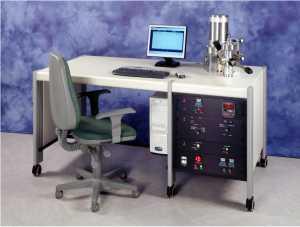|
Instrument Database:
Kore Technology - MS-1000 Compact Secondary Ion Time-Of-Flight Mass Spectrometer for Surface Analysis
| |
|

|
| |
|
| |
|
| Year of introduction |
|
| Status |
available |
| Company |
Kore Technology
|
| Categories |
Mass spectrometer: SIMS/SNMS
|
Many industries use surface analysis as a key element in product research and development, quality control and fault diagnosis. Static Secondary Ion Mass Spectrometry (static SIMS) gives detailed information on the chemistry and molecular structure of the topmost surface layer of a solid material; it is also highly sensitive. These attributes make static SIMS useful in a number of wide ranging areas such as surface engineering, microelectronics, coatings and packaging. The technique is increasingly being exploited in the pharmaceutical and biotechnology industries. However, typical static SIMS instruments are large, costly and difficult to operate. At Kore Technology we have developed MS-1000, a static SIMS of novel miniature design that is affordable, simple to use and capable of performing routine analysis with fast sample turnaround. We believe that the primary uses of MS-1000 will be in product quality control and fault diagnosis where fast turnaround and simple operation are key factors. Its low cost (under £ 100,000) and compact size will open up static SIMS analysis to new customers and applications that were not economically or technically possible with the presently available instrumentation.
All static SIMS instruments bombard solid material with one beam of ions (the 'primary' ions), then analyse the 'secondary' ions emitted from the sample in a mass spectrometer. The method requires a mass analyser of high efficiency because ion beam damage eventually modifies the chemistry of the surface. For this reason, time-of-flight SIMSs (ToF-SIMS) are optimal, and are now accepted as the instruments of choice. Conventional ToF-SIMSs are complex and expensive; they use large, many- ported vacuum chambers to accommodate the ion gun, mass analyser and other equipment. The genius of MS-1000 is the combination of ion gun and time-of-flight mass analyser in one compact unit. This unit not only generates the primary ions but also analyses positive secondary ions from the sample.
MS-1000 is based on Kore's Converging Annular Time-of-flight (CAT) technology, comprising an analyser only 250 mm in length with a folded flight path. An electron bombardment ion source is pulsed to direct bunches of primary ions through the folded analyser onto a solid target. After each pulse the same folded flight assembly is used with different voltages to converge positive secondary ions from the sample onto an electron multiplier detector; giving a nominal equivalent flight path of 600 mm. The spectrometer is operated with the sample target at ground potential. A charge compensation system comprising a 10 eV pulsed electron flood gun is used to prevent charge build-up in insulating samples.
- MS-1000 is a bench-top scale analyser that identifies the chemistry and molecular structure of the surface of solid samples.
- MS-1000 is a time-of-flight Secondary Ion Mass Spectrometer (SIMS) and operates in the static mode of SIMS; meaning that it is highly sensitive and analyses only the topmost layer of molecules on the sample.
- MS-1000 is unlike any other SIMS; it is affordable (under £100,000), very easy to use and has a fast sample turnaround time of 15 minutes.
- MS-1000 is designed for product quality control and fault diagnosis at or close to the point of manufacture; areas where other surface analysers have proved uneconomical or technically unfeasible.
- The combination of both mass analyser and ion gun in one unit makes MS-1000 the world's smallest static SIMS instrument!
MS-1000's applications include:
- Analysing adhesion in coatings and composite materials
- Contamination in semiconductor fabrication, pharmaceutical preparation and the environment
- Testing for biocompatibility
- Quality check of surface modification by plasma treatments e.g. polymers
- Analysis of organic binders used as paint pre-treatments
|
| Specifications |
|
Instrument Data:
- Primary Beam: The bombarding species is Ar+, of 2.5keV energy . Ions are focused to a circular spot of area 1.5 mm2 and are normally incident upon the sample surface. In a five minute experiment we estimate the primary dose to be 5x109 ions/cm2 - well below the static SIMS limit of 1013 ions/cm2.
- Secondary Ions: Positive secondary ions up to 1000 amu can be analysed with a mass resolution of 1000 (full width half maximum) measured at 100 amu.
- Software: The instrument operates from GRAMS/AI by Galactic Industries Corporation with Kore Technology additions for mass calibration and data analysis. An IBM compatible Pentium PC operating Microsoft Windows XP ® is used.
- Dimensions: The complete instrument is housed in a 19-inch electronics rack, 900 mm deep, as shown in the photo. This rack accomodates the complete vacuum chamber, its associated vacuum pumps and control electronics. A tower- or desktop-style PC is located externally. An optional table (1500 mm x 900 mm) can be included with the instrument for the PC (underneath), keyboard, mouse and monitor; it's also a useful space to prepare samples.
- Sample Handling: A typical sample will take 10 minutes to load and pump down to the vacuum required for analysis (some 2x10-7 torr). It takes around five minutes for analysis, giving a sample throughput of around four samples per hour. The sample holder accepts samples of up to 5 mm thick, width and length not exceeding 10 mm by 10 mm.
|
|